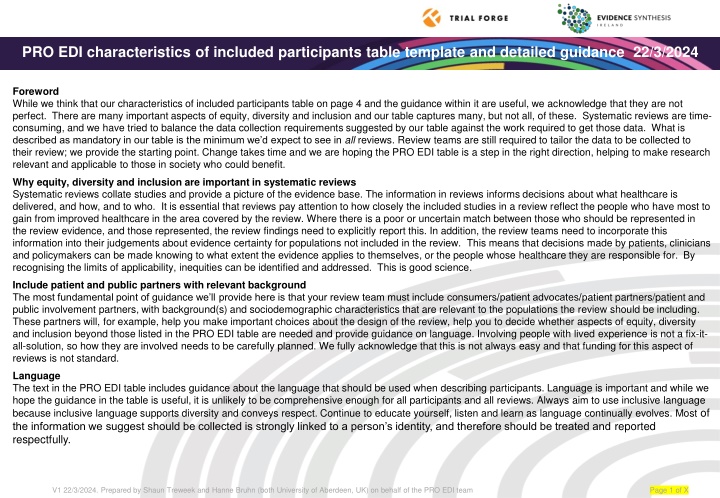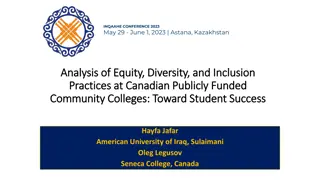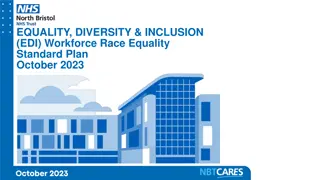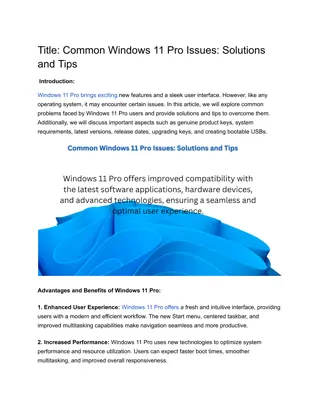
Importance of Equity, Diversity, and Inclusion in Systematic Reviews
Learn why equity, diversity, and inclusion are crucial in systematic reviews, and how the PRO.EDI table provides guidance on including relevant participants and using inclusive language. Explore the impact on healthcare decisions and the need for collaboration with patient advocates.
Download Presentation

Please find below an Image/Link to download the presentation.
The content on the website is provided AS IS for your information and personal use only. It may not be sold, licensed, or shared on other websites without obtaining consent from the author. If you encounter any issues during the download, it is possible that the publisher has removed the file from their server.
You are allowed to download the files provided on this website for personal or commercial use, subject to the condition that they are used lawfully. All files are the property of their respective owners.
The content on the website is provided AS IS for your information and personal use only. It may not be sold, licensed, or shared on other websites without obtaining consent from the author.
E N D
Presentation Transcript
PRO EDI characteristics of included participants table template and detailed guidance 22/3/2024 Foreword While we think that our characteristics of included participants table on page 4 and the guidance within it are useful, we acknowledge that they are not perfect. There are many important aspects of equity, diversity and inclusion and our table captures many, but not all, of these. Systematic reviews are time- consuming, and we have tried to balance the data collection requirements suggested by our table against the work required to get those data. What is described as mandatory in our table is the minimum we d expect to see in all reviews. Review teams are still required to tailor the data to be collected to their review; we provide the starting point. Change takes time and we are hoping the PRO EDI table is a step in the right direction, helping to make research relevant and applicable to those in society who could benefit. Why equity, diversity and inclusion are important in systematic reviews Systematic reviews collate studies and provide a picture of the evidence base. The information in reviews informs decisions about what healthcare is delivered, and how, and to who. It is essential that reviews pay attention to how closely the included studies in a review reflect the people who have most to gain from improved healthcare in the area covered by the review. Where there is a poor or uncertain match between those who should be represented in the review evidence, and those represented, the review findings need to explicitly report this. In addition, the review teams need to incorporate this information into their judgements about evidence certainty for populations not included in the review. This means that decisions made by patients, clinicians and policymakers can be made knowing to what extent the evidence applies to themselves, or the people whose healthcare they are responsible for. By recognising the limits of applicability, inequities can be identified and addressed. This is good science. Include patient and public partners with relevant background The most fundamental point of guidance we ll provide here is that your review team must include consumers/patient advocates/patient partners/patient and public involvement partners, with background(s) and sociodemographic characteristics that are relevant to the populations the review should be including. These partners will, for example, help you make important choices about the design of the review, help you to decide whether aspects of equity, diversity and inclusion beyond those listed in the PRO EDI table are needed and provide guidance on language. Involving people with lived experience is not a fix-it- all-solution, so how they are involved needs to be carefully planned. We fully acknowledge that this is not always easy and that funding for this aspect of reviews is not standard. Language The text in the PRO EDI table includes guidance about the language that should be used when describing participants. Language is important and while we hope the guidance in the table is useful, it is unlikely to be comprehensive enough for all participants and all reviews. Always aim to use inclusive language because inclusive language supports diversity and conveys respect. Continue to educate yourself, listen and learn as language continually evolves. Most of the information we suggest should be collected is strongly linked to a person s identity, and therefore should be treated and reported respectfully. V1 22/3/2024. Prepared by Shaun Treweek and Hanne Bruhn (both University of Aberdeen, UK) on behalf of the PRO EDI team Page 1 of X
Finally, although we have sought comment from people living in many countries, including the global south, it is also impossible for us to guarantee that these guidelines are applicable to every context, all countries and cultures. We expect (and apologise for) mistakes and shortcomings; we too need to keep educating ourselves. We would welcome comments on how the guidance can be improved and these can be sent to info@trialforge.org. Try not to create categories in equity, diversity and inclusion data Aggregating information using categories means that you lose information (it s the same problem as dichotomising continuous data). It also implies that those sharing a category share experiences and identities, when in reality they don t. Context is important and it is hard to know that data coming from contexts unfamiliar to the review team are being aggregated appropriately. Consequently, we recommend that reviewers simply collect what study authors provide without further amendments/processing. The study authors may have made unwise categorisation decisions themselves and as reviewers we might want to comment on that. But we shouldn t compound the problem. Intersectionality The PRO EDI table collects and reports participant characteristics through independent items such as gender and ethnicity, which can then be used to inform judgements about applicability of the evidence, especially to groups not represented within the included studies. This does, however, ignore the fact that that an individual may have a combination of characteristics that interact in complex ways to lead to worse (or better) health outcomes than if that individual had just one of the characteristics. This idea is known as intersectionality, a theoretical framework developed by Kimberl Crenshaw in 1989 that acknowledges this interaction and that this can reinforce and compound privilege, discrimination, and inequities. How to operationalise the concept of intersectionality when making judgements about the applicability of research evidence remains unclear. For now PRO EDI does not consider intersectionality in the characteristics of included participants table, and simply asks reviewers to keep intersectionality in mind when interpreting the information contained in the tables. See Interpreting the extracted EDI data . How to interpret what you have extracted Extracting the data suggested in the table on the next page is useful to describe participants in each included study. Perhaps more important though is that these data, together with that from other included studies, is used to make equity, diversity and inclusion judgements in your review, particularly about how certain you can be about applicability of the evidence. This is covered in a separate piece of guidance called Interpreting the extracted EDI data .
The PRO EDI characteristics of included participants table 1. The main aim of this table is to describe the characteristics of participants who were involved in the studies included in a review. Many of the items come directly from PROGRESS-Plus, a framework developed to support consideration of equity in systematic reviews. 2. This table below is designed with randomised trials in mind; however, we think it can be useful for other study designs too. The table may need to be modified to support other types of included studies, although this might not always be the case and might not be difficult when it is. 3. We recognise that many, perhaps most included trials may not report all the items requested in this table. Our intention is that reviewers and review users will interpret trial evidence considering these items and where information is lacking (e.g., around the characteristics of the people in the trial) that this uncertainty is made clear in the review. We also hope that this may influence how trials are designed and reported in the future. 4. Some papers describing included studies may provide the information below in supplementary files. Where possible, please try to access these and include the additional information. We acknowledge the extra work this involves. Mandatory or depends on review? Item Explanation Age Mandatory How to complete this item: We suggest ideallymean or median years together with an indication of spread such as range or standard deviation. For children, years or months. Mean or median together with an indication of spread, as above. Some studies will also (or perhaps only) report age in categories. It is up to the review team to decide whether to extract age category data in addition to reporting mean or median age. Examples A set of examples is available at [to follow]. Suggested English search terms to use when searching for this information in a study [age/years/months] Sex Mandatory How to complete this item: We suggest using Male, Female and Intersex. Other descriptions of intersex might be found and if so, they should be reported as reported by study authors. If authors have asked a question about trans history, this information should also be extracted. Sex and gender are different. Sex is usually a classification as male, female or intersex assigned at birth based on visual anatomy assessment (see https://pubmed.ncbi.nlm.nih.gov/35725304/). Sex is not binary. Sex is often thought of as an exclusively biological characteristic but it is a social construct in that it is based on an expectation of
Sex what bodies should look like. Understanding of sex may vary between countries and cultures. Language will change over time (and place) and the best approach is to use the terminology used in included studies but highlight any limitations this may introduce to the review as a whole. Sex and gender are often incorrectly used interchangeably, i.e., sometimes sex is listed but gender is reported (i.e. woman/man/non-binary instead of female/male/intersex). We err towards recommending that review teams correct sex to gender or gender to sex if required and then state Corrected to gender (or sex) by the review team . If the term sex isn t explicitly used in the study, but female/male/intersex reported, state Listed as sex by the review team . It is of course unclear how a person in the included study would respond to a question headed, say, Gender but was presented with options widely considered to represent sex. Regardless, review authors need to make a decision about how to handle interchangeable use of sex and gender, and then follow that decision consistently in their review. For children ( boys and girls ) see Gender below. Examples A set of examples is available at [to follow]. Suggested English search terms to use when searching for this information in a study [sex/male/female/trans] Gender Mandatory How to complete this item: We suggest using man and woman together with any other gender identities as reported by the included study. If authors have asked a question about trans history, this information should also be extracted. If no other gender identities than man and woman are reported, review authors should report this. Sex and gender are different. Gender is a social configuration that gathers the roles, behaviours, activities, feelings, attitudes and attributes that a given society typically associates with being masculine or feminine (see https://pubmed.ncbi.nlm.nih.gov/35725304/). Gender is not binary, nor is understanding of gender the same across the world.
Gender Language will change over time (and place) and the best approach is to use the terminology used in included studies but highlight any limitations this may introduce to the review as a whole. Try to avoid using non-binary as a catch all category if possible as some experience this practice as harmful. Sex and gender are often incorrectly used interchangeably, i.e., sometimes sex is listed but gender is reported (i.e. woman/man/non-binary instead of female/male/intersex). We err towards recommending that review teams correct sex to gender or gender to sex if needed and then stating Corrected to gender (or sex) by the review team . If the term sex isn t explicitly used in the study, but female/male/intersex reported, state Listed as sex by the review team . If only binary genders are reported, assume trans history was not collected, add: It is unclear whether and how people with a trans history would answer a binary gender question. Also see Sex above. When boys and girls are used for children, it should be listed as gender and include other gender identities. It should be acknowledged if the reviewers have corrected this from what was reported in the study. Examples A set of examples is available at [to follow]. Suggested English search terms to use when searching for this information in a study [gender/man/woman/trans] Sexual Identity Depends on review How to complete this item: We suggest using bisexual, gay, lesbian, heterosexual together with any other sexual identities as reported by the included study. Sex and gender are different. Gender is a social configuration that gathers the roles, behaviours, activities, feelings, attitudes and attributes that a given society typically associates with being masculine or feminine (see https://pubmed.ncbi.nlm.nih.gov/35725304/). Gender is not binary, nor is understanding of gender the same across the world. Whether sexual identity is appropriate as a separate item in addition to sex and gender depends on the review. How sexual identity is summarised and presented will vary from jurisdiction to jurisdiction. Language around Lesbian, gay, bisexual, trans and intersex (LGBTI+) is evolving and as the terms used apply to people s identities, they should be used with respect. The Equality Network in Scotland has produced a useful glossary (https://www.equality- network.org/resources/lgbti-glossary-booklet/) This item was judged by the PRO EDI development team and in external feedback to be an item that is extracted dependent on the review. This was not a unanimous view, but rather one where most people asked were satisfied that to balance data extraction against workload, this item should not be made mandatory. Sexual identify is, however, likely to have particular importance for some reviews (e.g. where delivery or receipt of care may be influenced by discrimination on grounds of sexual identify) and information on sexual identify should be extracted for those reviews.
Sexual Identity Examples A set of examples is available at [to follow]. Suggested English search terms to use when searching for this information in a study [bisexual/gay/lesbian/heterosexual/LGBTI+] Race, ethnicity and ancestry Mandatory How to complete this item: We suggest using the categories reported by study authors. Race, ethnicity and ancestry are not the same. Lu and colleagues have written a clear explanation of the differences (https://doi.org/10.1371/journal.pgph.0001060) but in summary (from Lu et al): race is a social construct carrying historical divisions made purely on the basis of physical characteristics, while ethnicity describes a shared cultural background which may include nationality, language, religion, and sometimes common biological characteristics. Ancestry refers to lineage and can refer to common geographic origin, genealogic, or genetic characteristics Use and acceptance of the terms race, ethnicity and ancestry varies around the world. Race as an ascribed attribute and skin colour, is a very sensitive topic and generally, legal frameworks limit collection of this type of information. Do not use Caucasian as the term is outdated and is associated with racist and pseudoscientific theories about race (https://doi.org/10.17226/26902). Reviewers should carefully consider which term or terms is/are most appropriate for their review, with help from relevant public contributor partners, provide their definition of the term in the body of the review and then use the term(s) consistently. Reviewers should avoid aggregating categories (e.g. Non-White / Black, Asian, and Minority Ethnic (BAME) / Black and Minority Ethnic (BME) ). Countries are increasingly becoming more diverse and therefore the range of different experiences and how people see themselves has also changed. Grouping together a range of ethnicities implies that they share experiences and identity when they may not. Another aspect of using aggregate categories is that they may not be associated with all relevant groups and this might result in further marginalisation of these groups. One example is using BAME or BME which have in the past been widely used in the UK but are not clearly associated with e.g. White ethnic minorities e.g., Gypsy, Roma and Traveller of Irish Heritage groups, some of the most under-served groups in the UK. Not all countries routinely collect race, ethnicity or ancestry data and those that do are likely to use different categories and find different terms acceptable e.g. race is less acceptable in the UK, Sweden and Denmark but is widely used in the USA. Hispanic and Latino are widely used in the USA but rarely in the UK. It is worth bearing in mind that the legal framework for collecting race, ethnicity and ancestry data varies between countries and is likely to affect what primary authors can report. Ethnicity data collection is for example very sensitive
Race, ethnicity and ancestry in Rwanda, where ethnic classifications were rejected by the government in 2012 in an attempt to help reconciliation after the genocide in 1994. In the European Union, no country imposes an absolute prohibition of ethnic data collection, although in France ethnic data collection is only possible under exceptions. Examples A set of examples is available at [to follow]. Suggested English search terms to use when searching for this information in a study [race/ethnicity/caste/white/black/minority/ancestry] Note that relevant search terms will be dependent on location and context of the study. Socio-economic status (SES) Mandatory How to complete this item: We suggest using the categories used by study authors. There is too much variation in the measures used to give an indication of socioeconomic status for us to try and standardise what is included and we do not recommend that review teams try to impose standardisation. The review team will have to decide which, if any, reported measures are helpful and relevant to the review and provide a justification. For those who want to learn more about assessment of socioeconomic status, have a look at the WHO Social determinants of health (https://www.who.int/health-topics/social-determinants-of-health#tab=tab_1) or Braveman and colleagues, Socioeconomic Status in Health Research: One Size Does Not Fit All (https://pubmed.ncbi.nlm.nih.gov/16352796/). The breakdown of socioeconomic should be as detailed as included study reporting allows. Categories may be used in some countries (e.g. Scotland uses a location-based measure called the Scottish Index of Multiple Deprivation), participant income bands might be used in others (e.g. participant income above or below certain amounts), or proxy measures (e.g. newspapers read by participants has been used to assess socioeconomic status in some studies). Reviewers should aim to provide as much detail as they can. Socioeconomic status is a sensitive area linked to a person s identify. Reviewers should carefully consider terms and terminology used as the acceptability of these might change over time. Public contributor partners would be able to provide some guidance to reviewers. Examples A set of examples is available at [to follow]. Suggested English search terms to use when searching for this information in a study Search terms might not be helpful but try [socio/occupation/employment/income/own]
How to complete this item: We suggest ideally mean or median years together with an indication of spread such as range or standard deviation. Alternatively, categories of grades completed as a number and percentage. Level of education Depends on review Whether level of education is appropriate as a separate item in addition to socioeconomic status depends on the review. How education levels are summarised and presented will vary from jurisdiction to jurisdiction. Review teams should not impose standardisation, but report what study authors present. This item was judged by the PRO EDI development team and in external feedback to be an item that is extracted dependent on the review. This was not a unanimous view, but rather one where most people asked were satisfied that to balance data extraction against workload, this item should not be made mandatory. Level of education is, however, likely to have particular importance for some reviews (e.g. where delivery or receipt of care may be influenced by discrimination due to level of education) and information on level of education should be extracted for those reviews. Examples A set of examples is available at [to follow]. Suggested English search terms to use when searching for this information in a study [edu/school] How to complete this item: This depends on the review but type of disability and severity would be examples of what could be extracted. Depends on review Disability Whether disability information should be extracted depends on the review. Disability may be the focus of the review in that supporting individuals with a particular disability may be the focus of the review, in which case it is clear that information about participant disability is required for each included study. This item was judged by the PRO EDI development team and in external feedback to be an item that is extracted dependent on the review. This was not a unanimous view, but rather one where most people asked were satisfied that to balance data extraction against workload, this item should not be made mandatory. Disability is, however, likely to have particular importance for some reviews (e.g. where delivery or receipt of care may be influenced by discrimination due to disability) and information on disability should be extracted for those reviews. Examples A set of examples is available at [to follow]. Suggested English search terms to use when searching for this information in a study [depends on review]



















